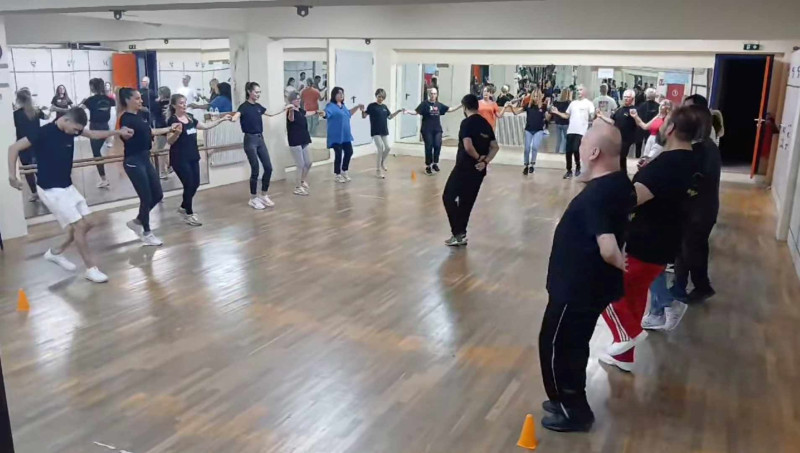More and more people, of all ages, are turning to learning traditional dances to exercise and socialize
Most of the time, the festival was held around the big plane tree, near the church, in the central square, on the day the village saint celebrated. Next to the outdoor grills and cauldrons that prepared the festive food, the priest, the mayor, the village president and the farm guard, held hands to give the signal for the dance to begin.
Today, several decades later, the halls of traditional clubs may lack village pies, live music and traditional instruments, but the rhythm of Sirtos, Tsamikos, Maleviziotis, Zagorisios and Zonaradikos invites people of all ages to join hands, with or without the familiar handkerchief, to drag the dance. There is no need, in fact, to wait for a festival to take place, as it used to happen very few times a year, since the clubs meet twice a week.
“In recent years, things have changed. Thirty, forty, fifty or sixty years ago, festivals and feasts were a part of people’s lives, but they did not happen many times a year. Now the courses organized by the cultural clubs concern every age and every level, while, as the scientific studies of the last thirty years prove, they have many and important benefits for health, as a form of aerobic exercise” Polydoros points out to APE-MPE Giannakis, professor of Physical Education, specialist in Traditional Dance, scientific associate of the Aristotle University of Thessaloniki.
How history, tradition and culture are transmitted
Elements of the past may be missing, but traditional dances still have the power to evoke memories in the older and transmit to the younger elements of a place’s history, tradition and culture.
According to Mr. Giannakis, when someone learns Pentozalis from Crete, Kotsari from Pontus, Zaramos from Macedonia and Baidouska from Thrace, he comes into contact with elements of the tradition of each place, with different types of music and with sounds from traditional instruments .
Benefits for mental and physical health
At the same time, significant benefits arise for mental and physical health. “For example, research on older people who danced traditional dances showed an improvement in their mental state, mood and quality of life. In women with breast cancer, an improvement in physical function, a reduction in depressive symptoms and an increase in life satisfaction were found. In the general population, benefits also include reducing stress and improving self-esteem and self-efficacy,” he adds.
Similar were the results of Mr. Giannaki’s research conducted in 2021, during the Covid-19 pandemic, with online traditional dance classes. 147 people participated in the research, who were divided into an intervention group and a control group. The first group included those who participated in the courses and the second group included those who did not. Based on responses to relevant questionnaires, all positive outcomes reported earlier were recorded in the intervention group.
In addition, he informs that in terms of physical health, “traditional dances improve cardiorespiratory endurance, help load the bones by reducing the risk of osteoporosis, improve muscle strength as well as static and dynamic balance, protecting against falls and injury from them. At the same time, they have a positive effect on back pain and lower back pain, sciatica and sciatic nerve irritation, achieving prolonged relief and even reducing the need for medication.”
In cultural clubs, people come closer
Just as in festivals and feasts an opportunity was given to acquaintances and relatives, from near or far places, to meet again, so also in the events of traditional clubs people from different regions get to know each other and meet.
“First of all, people hold hands, socialize, dance, cooperate, smile together,” emphasizes the Physical Education teacher and Traditional Dance Specialist. He also points out that “in the research with online traditional dance courses, people from different cultural clubs participated, for example from Thessaloniki and Giannitsa. When the research was completed, they continued to meet first online and then in person. They started communicating and became friends while maintaining their company.”
Lessons and in the diaspora
Traditional dances are a key point, which unites the past and the present, as well as the homeland with the expatriate. Mr. Giannakis typically mentions that today they are already happening online courses traditional dances, with the participation of expatriates from Australia, while many traditional clubs and institutions in Greece have included such courses in their program, uniting the Greek community in the interior and with the Greek communities abroad.
Source: Skai
I have worked as a journalist for over 10 years, and my work has been featured on many different news websites. I am also an author, and my work has been published in several books. I specialize in opinion writing, and I often write about current events and controversial topics. I am a very well-rounded writer, and I have a lot of experience in different areas of journalism. I am a very hard worker, and I am always willing to put in the extra effort to get the job done.











